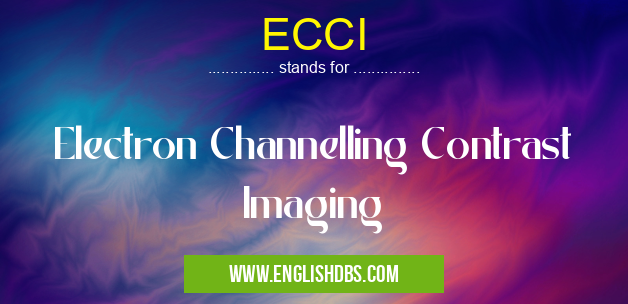What does ECCI mean in PHOTOGRAPHY & IMAGING
ECCI (Electron Channelling Contrast Imaging) is a high-resolution imaging technique used in scanning electron microscopy (SEM). It provides valuable information about the crystallographic orientation and defects in materials.

ECCI meaning in Photography & Imaging in Miscellaneous
ECCI mostly used in an acronym Photography & Imaging in Category Miscellaneous that means Electron Channelling Contrast Imaging
Shorthand: ECCI,
Full Form: Electron Channelling Contrast Imaging
For more information of "Electron Channelling Contrast Imaging", see the section below.
Principle of ECCI
ECCI utilizes the interactions between a focused electron beam and the crystal lattice of the sample. When the electron beam is aligned parallel to a major crystallographic axis, the electrons undergo coherent scattering. This results in a channelling effect, where the electrons are guided along the atomic planes, minimizing their interactions with the atoms.
Instrumentation
An ECCI system typically consists of:
- A scanning electron microscope (SEM)
- A retractable scintillator or backscattered electron (BSE) detector
- A goniometer for precisely orienting the sample
Applications
ECCI is widely used in various fields of materials science, including:
- Crystallography: Identifying crystallographic orientations and grain boundaries
- Defectology: Characterizing defects such as dislocations, stacking faults, and twins
- Phase identification: Distinguishing different phases based on their crystallographic structures
- Failure analysis: Investigating fracture surfaces to determine failure mechanisms
Advantages
- High spatial resolution (~10 nm)
- Sensitivity to crystallographic orientation
- Non-destructive and applicable to a wide range of materials
Essential Questions and Answers on Electron Channelling Contrast Imaging in "MISCELLANEOUS»PHOTOGRAPHY"
What is Electron Channelling Contrast Imaging (ECCI)?
ECCI is a technique used in scanning electron microscopy (SEM) to reveal the crystallographic orientation of a sample's surface. It involves directing a focused beam of electrons at a sample and detecting the backscattered electrons that are channeled along specific crystallographic directions.
How does ECCI work?
When an electron beam strikes a crystalline sample, some electrons are elastically backscattered. These backscattered electrons can be channeled along specific crystallographic directions within the sample. By detecting these channeled electrons, ECCI provides information about the crystallographic orientation of the sample's surface.
What are the advantages of using ECCI?
ECCI offers several advantages:
- High spatial resolution, allowing for the visualization of crystallographic information at the nanoscale.
- Non-destructive technique, preserving the sample's original structure.
- Sensitive to both crystal structure and defects, making it useful for characterizing materials and identifying dislocations or grain boundaries.
What types of samples can be examined using ECCI?
ECCI can be used on a wide range of crystalline materials, including metals, semiconductors, minerals, and ceramics. It is particularly useful for studying materials with complex microstructures or crystallographic defects.
What are the applications of ECCI?
ECCI has numerous applications in materials science, including:
- Characterizing crystallographic texture and grain orientation
- Identifying crystallographic defects and dislocations
- Studying phase transformations and grain boundary behavior
- Analyzing the microstructure of thin films and coatings
Final Words: ECCI is a powerful technique that provides detailed insights into the crystallographic structure and defects in materials. It is widely used in various scientific and industrial applications, contributing to the understanding and development of advanced materials.
